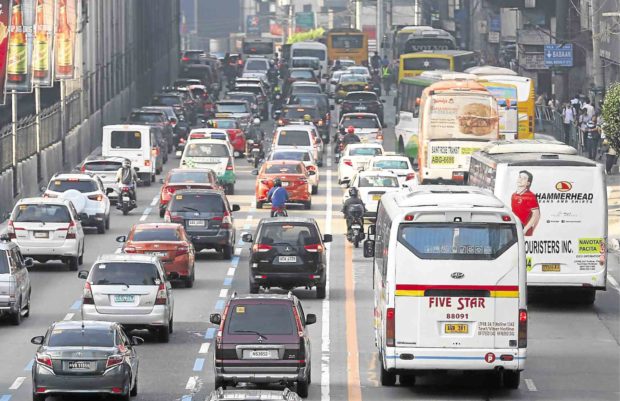MMDA eyes ‘road diet’ solution to heavy traffic on edsa

A DIFFERENT DIET More narrow lanes, according to a 2016 study, can also mean fewer accidents. A traffic expert, however, disagrees with the Metropolitan Manila Development Authority’s move to trim down lanes on Edsa from a width of 3.4 to 2.8 meters. —NIÑO JESUS ORBETA
The Metropolitan Manila Development Authority (MMDA) has come up with a new idea for fitting more vehicles on Edsa without actually expanding the busy thoroughfare: Create a new lane by making the existing ones “slimmer.”
In theory, the proposed “road diet”—reducing the width of Edsa lanes from 3.4 meters to 2.8 m—would increase the capacity of a limited road network, said MMDA traffic chief Edison Nebrija.
The proposal was first presented in September to the Department of Public Works and Highways which has jurisdiction over Edsa.
According to Nebrija, the 25-kilometer arterial road traversing Pasay to Caloocan City has a capacity of 250,000 vehicles on its northbound and southbound lanes.
The minimum speed for arterial roads is supposed to be 60 kph but the average speed on Edsa is only 12 to 14 kph.
Article continues after this advertisementThe latest MMDA figures peg the number of cars on the busy road at around 402,000 or nearly twice its capacity.
Article continues after this advertisementA new lane would hopefully allow at least 6,000 more vehicles on Edsa, Nebrija said. The move could also help reduce accidents on the road as based on the 2016 World Resources Institute study, narrower lanes were actually safer as these prevent sideswiping and reckless maneuvering.
In theory, reshaping Edsa is a more concrete solution than manipulating the number of cars on the road. But in practice, it means adding a lane to an imperfectly engineered highway where the number of lanes varies, said traffic expert Dr. Primitivo Cal.
At its narrowest—areas where there are flyovers or underpasses—Edsa has three lanes. At its widest, it has five lanes.
Edsa downgrading
By adding another lane, Cal explained, the MMDA would “downgrade” it from an arterial road (3.5 to 4 m) to a “collector” or city street (2.5 to 2.8 m) without actually solving the root cause of the problem: vehicular volume.
“I can see where the MMDA is coming from, in that Edsa doesn’t really function as an arterial road anyway,” he said.
“But if they [make] the lanes [narrower] but don’t reduce the minimum speed limit, then they would open up Edsa to more road crashes because there is less clearance between vehicles,” Cal added.